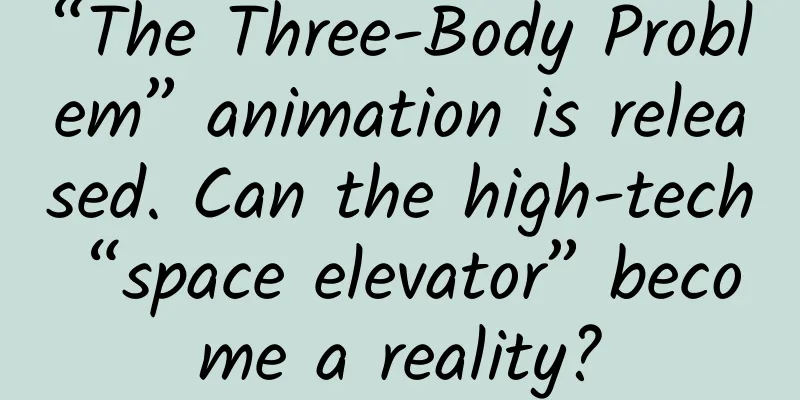“The Three-Body Problem” animation is released. Can the high-tech “space elevator” become a reality?

|
Space elevators have been a frequently mentioned topic in many science fiction works, including The Three-Body Problem. What are the technical difficulties of this project? Is there really hope that it will become a reality in the future? Written by reporter Duan Ran Graphic editor/Chen Yongjie New Media Editor/Lv Bingxin ▲ Schematic diagram of space elevator (Image source: NASA) The animation of "The Three-Body Problem", adapted from Liu Cixin's sci-fi novel series of the same name, is now being shown on Bilibili. The "space elevator" depicted in the play has made many people yearn for it. Enter the elevator, press the up button, and whoosh into space. Isn't it cool? At the 2022 International Symposium on Peaceful Uses of Space Technology (Health) held from November 18 to 20, Peter Swann, President of the International Space Elevator Consortium and member of the International Academy of Astronautics, proposed that in the future, space elevators, as permanent logistics infrastructure, can transport materials and personnel into space, becoming a new channel for entering space. Oftentimes, the boundary between science fiction and science seems so vague. Can humans really reach the other side of space easily by taking an elevator as depicted in science fiction novels? Science fiction writers inspired by scientists Space elevators have always been a hot topic for many science fiction writers, and have appeared in many science fiction works in different forms. In 1979, British writer Sir Arthur Clarke first described the "space elevator", a huge facility that bridges the empty space, in his science fiction novel "The Fountains of Heaven". Chinese science fiction writer Liu Cixin also used a considerable amount of space to describe in detail the giant device called "Sky Ladder" in "The Three-Body Problem". But in fact, in exploring the "space elevator", scientists, who are known for their rigor, are far ahead of novelists. ▲British writer Sir Arthur Clarke first described the "elevator to heaven" in his science fiction novel "The Fountains of Heaven" As early as 1895, when visiting the Eiffel Tower in Paris, France, Russian rocket expert and aerospace pioneer Tsiolkovsky was inspired by the construction of the iron tower and proposed to build a super-high iron tower on the ground that reaches the geosynchronous orbit and use an elevator to enter outer space. He also made a detailed design for this iron tower and calculated the height of the tower to be 35,786 kilometers. Tsiolkovsky's design, which is similar to the Tower of Babel in the Bible, is the origin of the "space elevator". However, after a series of calculations, he concluded that it is impossible to build such a super-high iron tower. In the 1960s, as humans entered space for the first time, the idea of building a space elevator to enter space was once again proposed by scientists. Soviet engineer Yuri Artchutanov envisioned building an "electric train" between space and ground to achieve space logistics transportation. Unlike Tsiolkovsky's idea of simply building a high tower with steel structures on the ground, he proposed a plan to build from space to the ground, that is, first launch a geosynchronous satellite, then extend a rope from the satellite to the ground, and fix it at one end on the ground to form the running track of the "electric train". In 1970, American scientist Jerome Pearson first theorized the concept of "space elevator" and published his related demonstration results in the "Journal of Space Engineering". Similar to the Soviet Union's "electric train" plan, Pearson envisioned "hanging" several cables made of special materials and high tensile strength from artificial aircraft in space to the ground as the main structure of the space elevator, and realizing the elevator's ascent to the sky in a way similar to "dragging a kite". Pearson's idea basically laid the foundation for the evolution of space elevators in academia. Subsequently, Pearson extended this concept to the moon. At an academic conference, he demonstrated in detail the idea of the Earth-Moon space elevator and summarized the main structure of the space elevator as the concept of "space wire". In Pearson's vision, the future "space wire" is a thin cable made of Kevlar fiber or other high-strength materials that is only slightly thicker than a pencil lead. ▲Pearson in his old age and his idea of a space elevator (Photo credit: the Washington Post) Although Pearson used quite complex scientific theories to prove the feasibility of space elevators in the future and their low cost compared to launch vehicles. However, since humans entered the space age, rockets have been the only technically feasible means of reaching the sky. Although Pearson's scientific arguments have received widespread attention in the academic community, the space elevator is indeed a concept far ahead of its time, so he himself was ridiculed by his peers with sarcastic remarks such as "Why not write science fiction?" Interestingly, Pearson's ideas really influenced the science fiction world. Clarke, a novelist living in Sri Lanka at the time, was inspired by his ideas about "space lines" and created the "sky elevator" in "The Fountains of Heaven". Insurmountable technical difficulties During the years of the space race, people spared no effort to improve the thrust and load of launch vehicles in order to achieve more efficient space transportation. Although the construction and operation costs of rockets are huge, compared with space elevators, the biggest advantage of rockets lies in "technical feasibility". From liquid/solid fuel engines to aerodynamic shapes to navigation and communications, rockets as a set of systematic engineering have been repeatedly practiced for decades. Although Pearson and other advocates have tirelessly demonstrated the convenience and economy of space elevators, at the time, it seemed that there were still too many insurmountable problems in the space elevator itself from paper data to engineering practice. The biggest challenge is the material of the elevator. Starting from Tsiolkovsky's super-tall iron tower, in order to offset the impact of the earth's rotation and ensure that the space elevator does not move relative to the ground facilities, scientists have locked the construction site in the geosynchronous orbit when demonstrating the space elevator. According to the space elevator envisioned by Pearson, if ordinary steel cables were used as the main material, then if such a cable was dropped from the geosynchronous orbit to the ground, the cable would be broken by its own weight at less than 9,000 meters, and the geosynchronous orbit is more than 30,000 kilometers away from the ground. When Pearson demonstrated the concept of "space wire", he only vaguely proposed to use high-strength materials as the main structure of the space elevator. The specific fiber material to be used was an insurmountable problem from the demonstration stage at that time. Secondly, to get from geosynchronous orbit to the ground, it is necessary to pass through more than 1,000 kilometers of atmosphere. The complex climate conditions in the troposphere, the temperature in the stratosphere that increases with altitude, and the gravitational effects from the moon and the sun all directly or indirectly test the stability of the space elevator. In addition, when taking the elevator to space, passengers will pass through the high-intensity radiation belt in the outer layer of the earth. How to protect passengers from being affected is another engineering problem. ▲Pearson's original conception of the space elevator (Photo credit: STAR.INC) In addition, considering that one end of the space elevator needs to be "tethered" to the geosynchronous orbit, the other end needs to have a base station near the earth's equator, and there are difficulties in selecting a site for the base station. The land near the equator is mostly tropical rainforest, so it is very difficult to build an elevator base station, and it is not cost-effective in terms of transportation costs. Therefore, floating base stations can only be built on the high seas. Pearson and his successors have proposed similar ideas, but how to ensure the stable operation of such a huge elevator base station under complex sea conditions is also a problem. A glimmer of hope Since the 1990s, materials science has achieved a series of major breakthroughs, which has given supporters of space elevators hope for solving the material problem. In 1993, carbon nanotubes were born and mass-produced two years later. This material has high strength (similar to diamond), good flexibility, and can be made into fibers, which is very suitable for making the "space wire" proposed by Pearson. As one of the strongest materials known in the world, carbon nanotubes have an intrinsic tensile strength of up to 100GPa (unit of pressure, i.e. gigapascal, 1 GPa=1000 000 000Pa), and the tensile strength per unit mass is 276 times that of steel. In theory, it is possible to achieve the effect of "four ounces to move a thousand pounds", which is very consistent with Pearson's idea that "the space wire is only slightly thicker than a pencil lead". Of course, with the current technology of carbon nanotubes, it is still a long way from being applied to the construction of space elevators. For example, the catalyst used to prepare carbon nanotubes easily loses its activity under high temperature, which leads to a great limitation on the length of carbon nanotubes. The cable length required for a space elevator is more than 30,000 kilometers. However, in the direction of carbon nanotubes, all countries are working hard to explore, and my country has made major breakthroughs in recent years. ▲Yuri Alchutanov, a former Soviet engineer, viewed the design of future space elevators at the 2010 National Space Elevator Conference (Photo source: the space elevator blog) In 2013, after extensive research on the growth mechanism, structure controllable preparation, and performance characterization of ultra-long carbon nanotubes, a research team led by Professor Wei Fei of the Department of Chemical Engineering at Tsinghua University prepared the world's first single carbon nanotube with a length of more than half a meter for the first time, setting a new world record. This creates the possibility of manufacturing cables needed for space elevators in the future. Professor Wei Fei once said: "The carbon nanotubes we prepared have perfect structures, excellent mechanical properties, and macroscopic lengths. We are currently engaged in the preparation of carbon nanotubes longer than one meter. In the next step, we hope to be able to prepare carbon nanotubes with a length of more than a kilometer and a macroscopic density. These works will open up a ray of hope for the preparation of space elevators!" It is precisely because of the continuous breakthroughs in cutting-edge technologies in recent years that scientists have begun to incorporate space elevators, which were originally just a flash between science and science fiction, into engineering design blueprints. In 1999, the Marshall Research Center of the National Aeronautics and Space Administration (NASA) published a report titled "Space Elevator: Advanced Infrastructure for Space", which detailed the feasibility of the space elevator from an official perspective. This was the first time that the concept of "space elevator" was officially recognized. ▲The concept map of the future space elevator released by NASA (Image source: NASA) Since then, from major aerospace official agencies to many companies interested in investing in the space industry, they have launched their own space elevator plans. For example, Russia has planned to cooperate with the European Space Agency to build a space cargo elevator. The United States has established a company called Lift Port Group to specialize in the research and development of space elevators. Japan has also announced the design plan for the elevator cable. Of course, there are still many technical problems in the design of these space elevators proposed so far, but after all, humans have opened up another way to connect space and the earth besides launch vehicles. I believe that with the continuous iterative development of technology, the relevant difficulties will be gradually solved, and the space elevator may not be far away from us. |
<<: Third-hand smoke is everywhere
>>: Can you let yourself go after the test turns negative? Experts urgently remind →
Recommend
A small project to make money on Douyin with zero cost, easy to operate and easy to make profits, the full version of the notes is shared with you
With the development of the times, the routines a...
The operation methodology of the large-sized "Nian Gao Mama" for mothers and infants
Today I will share with you a big account for mot...
Are Chinese rockets really starting to burn "coal"? | Expo Daily
Your best "insider" in the scientific c...
WeChat traffic generation: Who says you have to write soft articles to generate traffic?
In the past two days, friends often asked Yiwanli...
The traps of live streaming sales and the skills of live streaming sales by celebrities!
Recently, whenever someone talks about new consum...
Take stock of the flowers that bloom on summer nights and smell their fragrance to cool off
Produced by: Science Popularization China Author:...
WeChat has been updated to version 8.0.15, adding seven new practical features. I really love it.
With the continuous updates of WeChat, it has now...
How to make your marketing reach high-value people on Zhihu?
Zhihu is a platform that brings together a group ...
3 kinds of food that are good for your eyes, remember to eat more! See if there is any you like?
In today's society, people spend more and mor...
Three major pitfalls in developing WeChat mini-programs
Trap 1: "Mini Program Third-Party Platform&q...
What is the focus of brand marketing in 2021?
With the disappearance of traffic dividends, the ...
Stomach pain may not really be caused by the stomach!
In clinical work, we often encounter patients who...
Milk nutrition is more than just calcium supplement, but drinking it incorrectly can be a "burden"
Milk is known as "white blood". It is n...
In-depth understanding of viewport in mobile front-end development
In-depth understanding of viewport in mobile fron...
Lao Guang's 12 logical reasoning classes
Introduction to Lao Guang’s 12 logical reasoning ...









